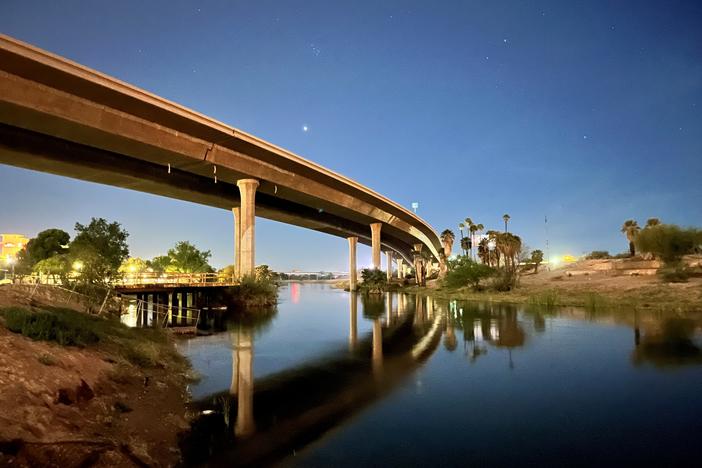Section Branding
Header Content
Wind turbines on sacred Osage land must be removed, according to court ruling
Primary Content
A judge in Oklahoma has ordered the removal of a massive wind farm from tribal land because its owners failed to get proper permits more than a decade ago.
Transcript
JUANA SUMMERS, HOST:
A federal judge is ordering three companies to remove more than 80 wind turbines from an Oklahoma prairie. While it may be a setback for green energy production, it's a victory for citizens of the Osage Nation, which worked to remove the turbines from land they say is sacred. Allison Herrera from APM Reports has the story.
(SOUNDBITE OF WIND TURBINES ROARING)
ALLISON HERRERA: That's the sound of wind turbines on the prairie on a cold January morning north of Pawhuska in Osage County, the horizon where spectacular sunrises and sunsets are pierced by the blades whipping through the sky. The turbines have been here for nearly a decade, but their future may be short-lived. Last month, a federal judge ordered Enel Green Power North America and two other companies responsible for the wind farm to tear them down.
WILSON PIPESTEM: The wind energy companies only reached agreements with the county and the landowners and avoided the Osage Nation.
HERRERA: That's Wilson Pipestem. He represented the Osage Minerals Council, which is part of the Osage Nation. It's responsible for the oil and gas development on the reservation. He says what's underneath the ground is not property of the landowners. It's held in trust for the Osage Nation by the federal government.
PIPESTEM: The wind energy companies ignored the sovereignty of the Osage Nation.
HERRERA: Pipestem is referring to the 1906 Osage Allotment Act, which gave the Osage Nation rights to the oil and gas underneath their land. The development of that oil and gas during the 1920s put a target on Osage citizens' back, which is depicted in the movie, "Killers Of The Flower Moon." That act also applies to the rocks and soil underground. In court, the wind farm companies argued they didn't need permission because their turbines are above ground. But wind turbines need a foundation, and in court, lawyers for the federal government and the Osage showed a video blasting rock for that foundation.
(SOUNDBITE OF EXPLOSION)
HERRERA: The blast, the lawyers argued, proved that the companies were going underground and mining without a permit. The judge agreed.
CAROL CONNER: It's a very sacred space.
HERRERA: That's Carol Conner. She and her late husband, Joe Conner, worked for more than a decade to raise awareness about how the wind farm damages the prairie.
CONNER: Osages believed that the horizon itself was a sacred space, and you have to pretty much live on the prairie to see the horizon like Osages do.
HERRERA: One of the biggest reasons Osages are opposed to the wind farms is that they believe their ancestors may be buried on higher elevation or ridges on the prairie.
CONNER: Most of the wind towers are on high ridges. That's where the wind blows the strongest. And never did the wind farm people follow federal guidelines and do any archaeological surveys, or figure out if there was any reason they shouldn't build there.
HERRERA: One of the companies, Enel Green Power North America, didn't agree to an interview but sent a statement saying they don't agree with the judge's order to remove the 84-turbine wind farm and may appeal. Carol says her late husband Joe wasn't against wind energy, and neither are other Osage citizens. She says the company should have just gotten a permit before putting up the first turbine in 2014.
CONNER: That is what's wrong. It's not about the wind energy itself. It's about - we violated the nation's rights in doing this.
HERRERA: The companies say removing the turbines could cost them around $300 million. A court date is yet to be set to determine if they must compensate the Osage Nation for use of the material they dug up more than a decade ago.
For NPR News, I'm Allison Herrera in Pawhuska, Okla.
(SOUNDBITE OF MUSIC) Transcript provided by NPR, Copyright NPR.
Bottom Content



